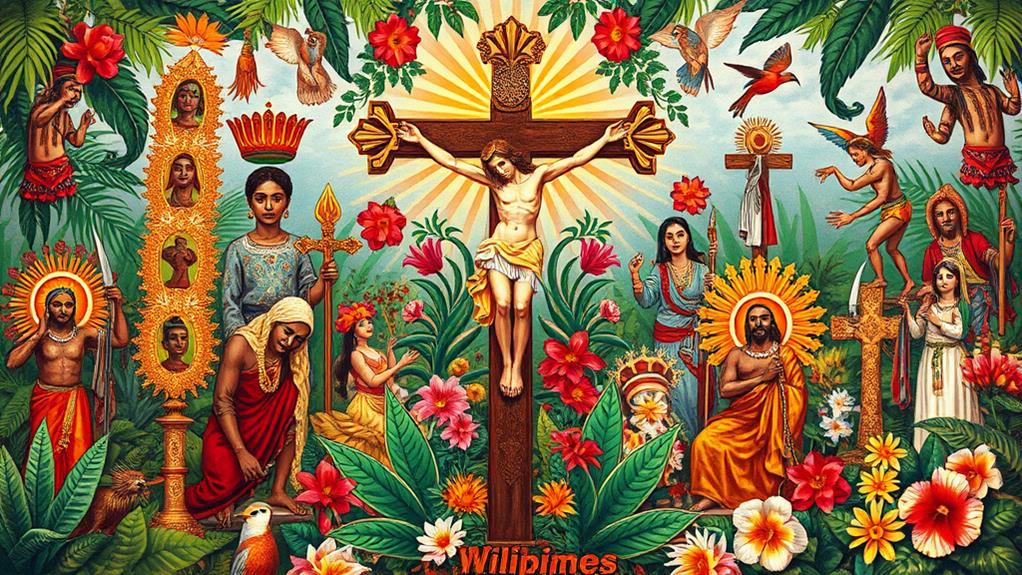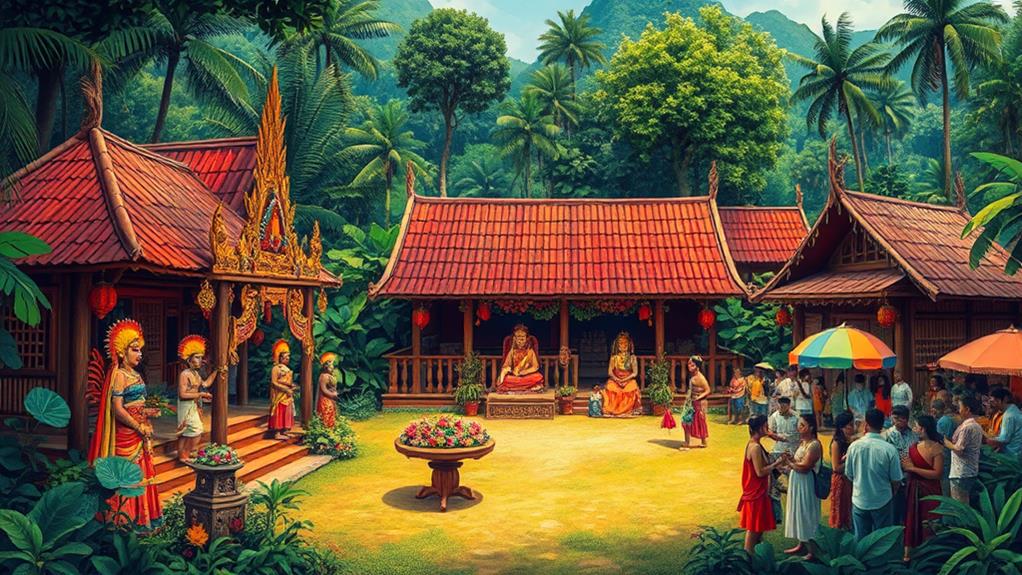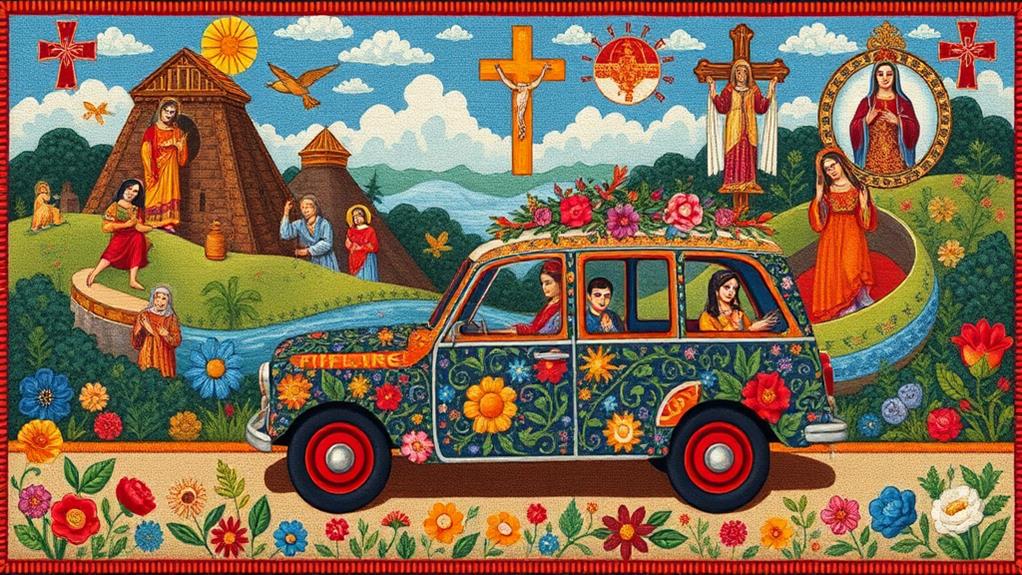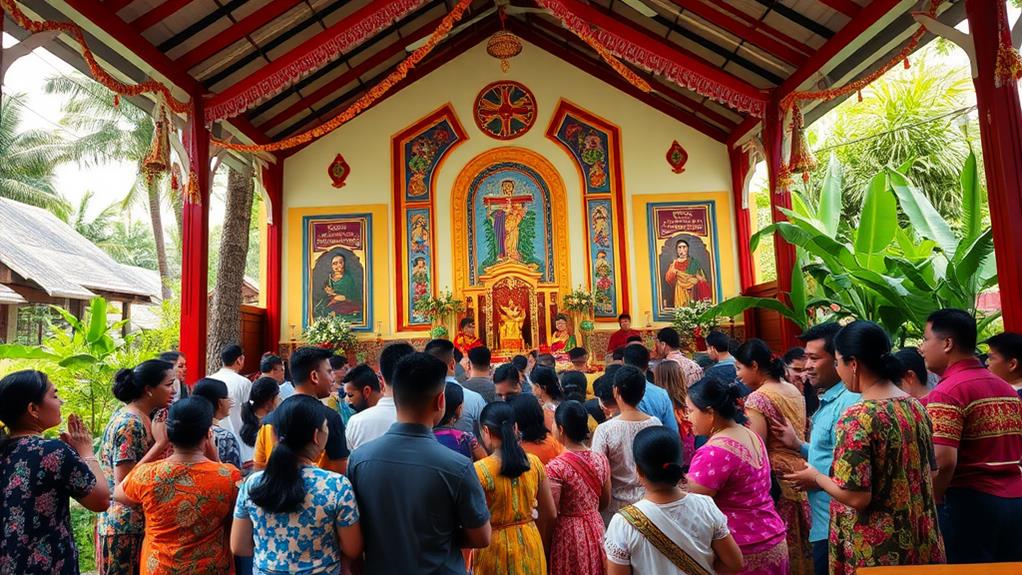Religion is a fundamental aspect of Filipino identity, deeply intertwined with cultural traditions and historical narratives.
The dominant Catholic faith, practiced by approximately 80% of Filipinos, blends with indigenous beliefs during festive celebrations. For instance, in rituals, prayers to saints coexist with offerings to ancestral spirits, reflecting this fusion of faiths.
The Catholic Church significantly influences moral values and social activism, showcasing its powerful presence in Filipino life.
The ongoing evolution of religious practices hints at broader societal changes, revealing a rich tapestry of identity waiting to be uncovered.
Historical Development of Religion

The Philippines' Rich Spiritual Heritage
The historical development of religion in the Philippines is a unique blend of indigenous beliefs, colonial influences, and contemporary movements. Before Spanish colonialism, indigenous practices thrived, with Bathala as the supreme deity and shamans serving as mediators between the spiritual and earthly realms. This rich spiritual landscape was characterized by vibrant practices, such as rituals and ceremonies, that were an integral part of daily life.
Spanish Colonization and the Introduction of Catholicism
In 1565, Spanish colonizers introduced Catholicism, which led to mass conversions and a fundamental shift in the religious map of the archipelago. The Catholic Church played a significant role in shaping the country's religious landscape, with missionaries integrating indigenous beliefs into Catholic practices.
This blending of practices resulted in a unique fusion of traditions, evident in community celebrations where the Santo Niño shared a feast with ancestral spirits.
The American Era and the Emergence of Protestantism
During the American era, Protestantism was introduced, and nationalized churches like the Aglipayans emerged. Despite these developments, the Catholic Church maintained its dominant role in the country.
However, in recent years, various sects and fundamentalist groups have challenged the Catholic Church's dominance, indicating a dynamic shift in religious engagement that continues to shape Filipino identity.
Catholicism's Influence on Identity
Catholicism's influence on Filipino identity is deeply rooted and pervasive. This is evident in everyday life, from the vibrant colors of local fiestas to the solemnity of Holy Week observances. The Catholic Church stands tall in towns and cities, often serving as the heart of Filipino society. Approximately 80% of the population identifies as Catholic, which intertwines religious practices with cultural traditions, creating a rich tapestry of identity.
Major celebrations blend indigenous customs with Catholic rituals, showcasing how faith shapes community life. For example, Christmas and local fiestas combine traditional practices with Catholic traditions, such as Simbang Gabi (Night Mass) and processions.
The Catholic Church plays a pivotal role in education, operating numerous schools that impart not only academic knowledge but also moral and ethical values crucial for shaping the youth's identities.
The Church has historically been a catalyst for social change, engaging in activism during pivotal moments, such as the People Power Revolution. This involvement strengthens community bonds and reinforces national identity.
Through education, social activism, and cultural traditions, Catholicism continues to mold the Filipino identity, making it an inseparable part of the cultural landscape.
Indigenous Beliefs and Practices

Indigenous Beliefs and Practices in the Philippines
The Philippines has a rich spiritual landscape that predates colonial influences, with pre-Hispanic Filipinos practicing a complex system of indigenous beliefs. At the center of this system was Bathala, the supreme deity. These beliefs emphasized the importance of spiritual harmony, guiding daily life.
Rituals were a crucial part of this spiritual framework, often involving offerings and sacrifices aimed at appeasing both benevolent and malevolent spirits. Shamans and priests played key roles, acting as intermediaries between the community and the spiritual realm, and were celebrated for their supernatural abilities.
Ancestor veneration was another essential aspect of Filipino spirituality, with wooden and metal images representing ancestral spirits. This practice highlighted the significance of lineage in Filipino spirituality.
Key Elements of Indigenous Beliefs and Practices:
- The pantheon of gods and their roles: Bathala was the supreme deity, surrounded by a pantheon of gods and goddesses with distinct roles and responsibilities.
- Types of rituals performed: Rituals included offerings and sacrifices to appease spirits, as well as ceremonies to mark important life events, such as birth, coming of age, and death.
- The significance of shamans in the community: Shamans were revered for their supernatural abilities and played a crucial role in maintaining spiritual harmony.
- The practice of ancestor veneration: Ancestor veneration emphasized the importance of honoring one's ancestors and respecting their role in shaping the community's spiritual identity.
These elements showcase how indigenous beliefs continue to influence Filipino identity, weaving a rich narrative of spiritual harmony and cultural heritage.
Contemporary Religious Landscape
The Philippines' Contemporary Religious Landscape
The contemporary religious landscape in the Philippines is a rich tapestry of faith shaped by centuries of indigenous beliefs and cultural influences. Around 80% of Filipinos identify as Catholic, which has a significant impact on cultural norms and social engagements.
However, the Catholic Church's dominance is being challenged by emerging small sects and fundamentalist groups, which are reshaping community dynamics. A low priest-to-people ratio has led to decreased community engagement from the Church, pushing grassroots movements to the forefront.
These movements often combine faith with social action, focusing on human rights issues, and frequently find themselves at odds with government authorities.
The Catholic Church influences political discourse, advocating for marginalized voices and social justice. Additionally, the presence of native clergy is becoming more pronounced, as they address the rising influence of new sects and local community concerns.
The historical blend of folk Christianity with indigenous animism has resulted in a unique syncretism that characterizes Filipino spirituality today.
This evolving religious identity remains deeply tied to the nation's cultural fabric, reflecting a rich interplay of elements.
Cultural Syncretism and Identity

Filipinos often blend indigenous beliefs with foreign influences, creating a rich cultural syncretism that shapes their spiritual practices. This unique blend of faiths is evident in various forms, including vibrant festivals and everyday rituals.
Festivals in the Philippines celebrate both Roman Catholic saints and ancestral spirits. For example, the Sinulog Festival in Cebu honors the Santo Niño, a Catholic saint, alongside indigenous deities. These festivals showcase the intermingling of different faiths.
Rituals in the Philippines also reflect this cultural syncretism. Many Filipinos offer food and drinks to ancestral spirits, alongside prayers to Jesus and other Catholic saints. This blending of animism and Christianity is a common practice.
Some churches in the Philippines, like the Aglipayans, have become nationalized, emphasizing nationalist identity alongside Catholic teachings. This unique blend of faith and nationality resonates with many Filipinos.
Literature and art in the Philippines also reflect the fusion of Spanish colonial heritage and Filipino identity. For instance, the works of national hero José Rizal often explored the tension between colonial and indigenous cultures. This cultural syncretism is a hallmark of Filipino identity.
Over 80% of Filipinos identify as Catholic, yet many engage in folk practices that highlight the complexity of their religious identity. This cultural syncretism enriches the collective Filipino identity, illustrating a continuous negotiation between colonial history and indigenous roots.
It embodies the unique essence of Filipino spirituality, bridging the past with the present.
Political Activism and Religion
The Catholic Church plays a significant role in shaping political landscapes and community movements in the Philippines. This goes beyond spiritual guidance, as the Church has historically inspired nationalist sentiments, especially during the fight against Spanish colonial rule. For example, figures like GOMBURZA symbolized the quest for justice and independence.
During the Marcos regime, the Church emerged as a beacon of hope. Cardinal Jaime Sin urged citizens to demand civil liberties and social justice. This led to the Church's influential role in the People Power Revolution of 1986, where it guided millions in a peaceful protest against dictatorship.
This spontaneous mobilization not only reshaped governance but also reinforced the Church's role in advocating for democracy.
Today, the Church continues to engage with pressing social issues. It advocates for poverty alleviation and human rights, asserting its presence in contemporary political discourse.
As Filipino identity evolves, the Church navigates challenges from emerging sects and social movements, maintaining its status as a significant player in the socio-political landscape. The Church's presence is deeply intertwined with political activism, shaping the Filipino experience.
How Do Indigenous Religions Contribute to Filipino Identity Formation?
The indigenous religions in the Philippines play a crucial role in shaping the Filipino identity. These belief systems, deeply rooted in the country’s history and culture, influence various aspects of Filipino life, including language, traditions, and values. Through their practices, the indigenous religions philippines contribute to the unique identity of the Filipino people.
Role of Faith in Community

Faith is a fundamental aspect of Filipino community life, influencing various aspects of cultural celebrations and social support systems. The strong Catholic presence, with around 80% of the population identifying as Catholic, drives many communal activities.
Faith-based events foster a sense of community belonging, as seen in events like the Feast of the Black Nazarene, which draws millions of people together in shared devotion. This event not only reflects deep-rooted beliefs but also strengthens community bonds.
Religious institutions serve as crucial support networks, particularly in underprivileged areas. They provide:
Educational opportunities through Catholic schools, ensuring access to quality education for all.
Social services that address community needs, such as healthcare and food assistance.
Platforms for social justice initiatives, empowering communities to advocate for their rights.
Spaces for grassroots movements to emerge, allowing community members to drive positive change.
Faith strengthens community ties and inspires collective action, making it a unifying force and a catalyst for social change. It reflects the hopes and aspirations of the Filipino people, shaping their identity and culture.
Challenges and Future Outlook
Challenges Facing the Catholic Church in the Philippines
The Catholic Church, which represents around 80% of the Filipino population, faces significant challenges that threaten its influence and community connections.
Emerging sects are attracting young people who seek spiritual fulfillment beyond traditional practices. This shift complicates the Church's role in a predominantly Christian nation, as the low priest-to-people ratio further diminishes personal engagement.
Religious Tensions in Mindanao
In Mindanao, historical grievances fuel religious tensions and separatist movements, affecting how communities perceive faith's role in identity.
Young people navigate a complex landscape of modern influences while grappling with traditional values. For instance, studies show that faith can serve as a coping mechanism amid rising mental health concerns, emphasizing its importance in youth culture.
The Church's Role in Social Justice
The Church is increasingly active in social justice advocacy, tackling issues like poverty and human rights, which resonate with the younger generation's desire for meaningful change.
As the 500-year celebration of Christianity approaches, there's a growing emphasis on ecumenism and interreligious dialogue. This need for deeper understanding challenges the Church to evolve, engaging with young people in ways that honor both tradition and contemporary relevance, ensuring its place in Filipino identity formation for years to come.
Questions and Answers
What Is the Role of Religion in the Formation of Identity?
Religion plays a significant role in shaping one's identity. This is because spiritual beliefs are often intertwined with community values, fostering a sense of belonging and connection to others.
For instance, religious rituals and practices not only connect individuals to a higher power but also to their community. Participating in festivals and gatherings strengthens social bonds, promoting unity and a shared sense of purpose.
Observing how religious beliefs manifest in daily life reveals a rich cultural tapestry. In this tapestry, faith influences personal choices, such as dietary restrictions or charitable giving, and enhances the collective spirit of the community.
For example, in many religious communities, acts of kindness and volunteering are encouraged, promoting a sense of social responsibility and compassion.
What Factors Influenced the Formation of Filipino Identity?
The Formation of Filipino Identity
Filipino identity was shaped by a blend of colonial history and indigenous beliefs. The country's colonial past, which spanned over three centuries, introduced Christianity, the Latin alphabet, and Western customs. These foreign influences merged with the existing indigenous beliefs and practices of the native population.
Migration patterns also played a significant role in forming Filipino identity. The country's strategic location made it a melting pot of different cultures. Chinese traders, Arab merchants, and Spanish colonizers, among others, brought their distinct customs and traditions, which eventually merged with the local culture.
Language evolution enriched communication and connection among Filipinos. The development of the national language, Filipino, also known as Tagalog, facilitated interaction among people from different regions. This language is a blend of various dialects and languages, including Spanish, Chinese, and Arabic.
Social structures, influenced by historical events, shaped community dynamics. The barangay system, a pre-colonial social structure, emphasized community and cooperation. The arrival of foreign colonizers introduced a new system of governance, which further shaped social relationships.
Economic factors drove interactions among different groups. The galleon trade between Mexico and the Philippines, which lasted for over two centuries, brought economic prosperity and cultural exchange. This trade also introduced new products, such as corn and tomatoes, which became staples in the Filipino diet.
Each of these elements interwove, creating a unique tapestry that defines Filipino identity today, reflecting resilience, adaptability, and a rich cultural heritage rooted in both tradition and change.
What Is the Religious Influence in the Philippines?
The Philippines is a predominantly Catholic country, with approximately 86% of the population identifying as Catholic. This dominant faith has a significant influence on daily life, shaping traditions and community rituals.
For example, the celebration of Catholic holidays like Christmas and Holy Week is a major part of Filipino culture.
In addition to Catholicism, other faiths also have a presence in the country. Indigenous beliefs and Protestant denominations are also practiced, particularly in rural areas.
In these regions, parish priests often serve as community leaders, playing a vital role in the social and cultural fabric of the community.
The religious landscape in the Philippines isn't static, with new sects emerging in response to changing values. This dynamic interplay of beliefs has a profound impact on social norms and collective identity, contributing to the country's rich cultural heritage.
What Role Does Religion Play in Cultural Identity?
Religion plays a significant role in shaping cultural identity. It influences daily life and celebrations, creating a sense of community and belonging. For example, attending religious services, such as Mass, brings people together and reinforces communal bonds.
Vibrant festivals and spiritual traditions also play a crucial role in cultural identity, often blending indigenous beliefs with Catholicism. These unique cultural practices showcase a rich tapestry of history and symbolism, making religion a cornerstone of collective identity and everyday experiences.